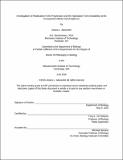| dc.contributor.advisor | Terry L. Orr-Weaver. | en_US |
| dc.contributor.author | Alexander, Jessica L. (Jessica Lynne) | en_US |
| dc.contributor.other | Massachusetts Institute of Technology. Department of Biology. | en_US |
| dc.date.accessioned | 2016-09-13T19:07:57Z | |
| dc.date.available | 2016-09-13T19:07:57Z | |
| dc.date.copyright | 2016 | en_US |
| dc.date.issued | 2016 | en_US |
| dc.identifier.uri | http://hdl.handle.net/1721.1/104168 | |
| dc.description | Thesis: Ph. D., Massachusetts Institute of Technology, Department of Biology, 2016. | en_US |
| dc.description | Cataloged from PDF version of thesis. | en_US |
| dc.description | Includes bibliographical references. | en_US |
| dc.description.abstract | The Drosophila follicle cell amplicons are a well-established model system of origin firing, and have been extensively used to investigate the cis and trans-acting elements that govern origin regulation in metazoan development. Precisely timed origin initiation from defined genomic locations also has made the amplicons a powerful model system to delineate control of replication fork progression. We utilized this system to survey fork progression across diverse genomic positions from amplicons generated at ectopic genomic positions. Comparative genome hybridization (CGH) analysis reveals fork progression varies with the position of insertion, indicating fork movement is influenced by sequence, chromatin and/or chromosome architecture. Additionally, we have developed a slope analysis tool to measure changes in fork progression between different amplicons, as well as within a single amplified site. Together the CGH survey and slope analysis can be used to discover positions that are inhibitory to fork progression and delineate intrinsic sources of fork stalling across the genome. Furthermore, we utilized the amplicons to investigate the consequences of re-replication on fork stability. We find that double-strand breaks (DSBs) are generated at positions of active replication forks, supporting the model that head-to-tail collisions between adjacent replication forks generate DSBs during rereplication. A single fork collision and collapse event would block all subsequent forks, suggesting efficient break repair is required for continued fork movement at the amplicons. To define the pathways responsible for maintaining re-replication fork elongation, we developed the half-maximum distance analysis to measure global fork progression at each site of re-replication in the absence of various DNA damage response (DDR) and repair components. We find that fork progression is reduced in various DDR mutants, suggesting the DNA damage response is essential to maintain overall fork movement during re-replication. We also have begun to define the mechanisms of DSB repair during re-replication, and find the preferred pathway is influenced by repair efficiency and amplicon position. Our analysis thus establishes the Drosophila follicle cell amplicons as a re-replication model system and suggests that DSB repair pathway choice during re-replication is governed by genomic position, reaction kinetics and repair pathway competition. | en_US |
| dc.description.statementofresponsibility | by Jessica L. Alexander. | en_US |
| dc.format.extent | 161 pages | en_US |
| dc.language.iso | eng | en_US |
| dc.publisher | Massachusetts Institute of Technology | en_US |
| dc.rights | M.I.T. theses are protected by copyright. They may be viewed from this source for any purpose, but reproduction or distribution in any format is prohibited without written permission. See provided URL for inquiries about permission. | en_US |
| dc.rights.uri | http://dspace.mit.edu/handle/1721.1/7582 | en_US |
| dc.subject | Biology. | en_US |
| dc.title | Investigation of replication fork progression and re-replication fork instability at the Drosophila follicle cell amplicons | en_US |
| dc.type | Thesis | en_US |
| dc.description.degree | Ph. D. | en_US |
| dc.contributor.department | Massachusetts Institute of Technology. Department of Biology | |
| dc.identifier.oclc | 958132001 | en_US |
